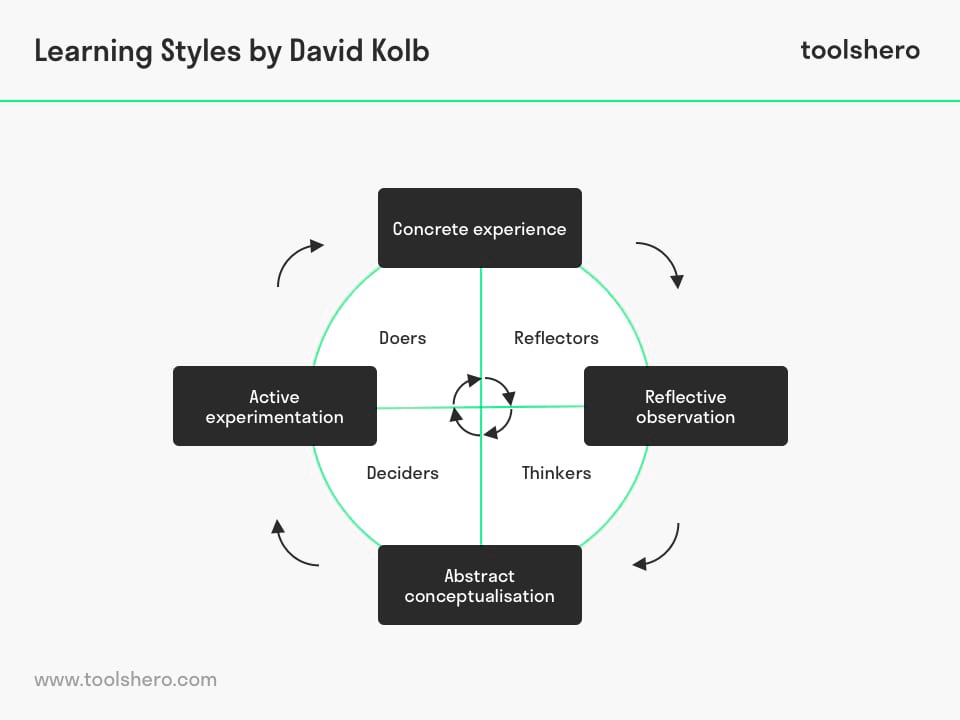Kolb Reflective Cycle Explained

Kolb Reflective Cycle: this article explains the Kolb Reflective Cycle, further developed by David Kolb, in a practical way. It covers what the model of reflection is and what the four stages of learning and the different learning styles are. After reading you will understand the basics of this learning and reflection theory. Enjoy reading!
What is the Kolb Reflective Cycle?
The American psychologist David Kolb developed, together with Roger Fry the Experiential Learning Model (ELM) for effective learning in the 1970s.
This model of reflection, the Kolb Reflective Cycle is also known as the four stages of learning or the Kolb’s Learning Styles. The Learning Styles theory named the four stages of learning, made clear that there is not just one learning style but that there are more methods and that individuals have their own preferred learning styles.
Kolb Reflective Cycle and Diversity
David Kolb discovered that people are inclined to particularly develop the learning phase they are good at. This is why he thinks that it is good to pay attention to the ways of learning they are less proficient at.
Because of such diversity, people can go through the Kolb Reflective Cycle in a more complete and balanced way so that each phase gets a proportionate amount of attention. A group of people exhibits this diversity by nature as a result of which the group members complement each other as a matter of course.
Kolb Reflective Cycle: Four Stages of Learning
David Kolb bases his four stages of learning on two major opposite dimensions, namely “Concrete versus Abstract” and “Active versus Reflective”.
In practice, it appears that adults (as opposed to children) depending on experience and stage of life, first need to unlearn things before they can learn something new.
Sometimes people need to come to terms with (undesired) experiences before they are open to new views.
What are the Learning Styles?
Within the dimensions, the Kolb Reflective Cycle theory is based on a stage theoretical model of reflection.

Figure 1 – Kolb model of reflection (1984)
David Kolb distinguishes four learning behaviours with four learning styles:
Doers
Doers displays a combination of active experimentation and concrete experience.
Doers prefer situations in which they can set to work as quickly as possible and they learn best when there is room for gaining immediate experience by doing things. Doers are open to new learning opportunities, good at solving problems and they are challenged by taking on unfamiliar tasks.
Reflectors
Reflectors have a preference for concrete experience and reflective observation. Reflectors like to think about something first and they are great at lateral problem-solving.
They want to consider all possible angles and implications of a problem and they never fail to see new approaches and solutions. They are dreamers that do not wish to be hurried and they want to take time before making a decision.
Thinkers
Thinkers combine reflexive observation with abstract conceptualization. They like turning their observations into coherent hypotheses and theories.
They do well at verbal reasoning and they prefer to work independently. They learn best in structured learning situations with clear goals, theories and models. They would like to be able to ask questions and discuss topics.
Deciders
Deciders have a preference for abstract conceptualization and active experimentation. Deciders like trying out theories in practice.
They often take the initiative, are problem-solvers and they make decisions. They learn best by clear and briefly formulated rules and principles they can immediately implement in practice.
They are practical people that do not like wasting time.
Four Stages of the Kolb Reflective Cycle
The Kolb Reflective Cycle is a cyclical process in which people must work through each of the four learning stages.
This does not necessarily have to be from the same starting point, but preferably in the same order.
According to David A. Kolb the learning process becomes easier by going through the four stages of learning despite people’s preference for a certain stage.
Relationship within the Kolb Reflective Cycle
Until recently, many training courses focused on the assimilation learning style; reflection and theory building. People were taught how certain things interrelate and how they can be considered in a theoretical framework. Often, little attention was paid to the accommodating learning style (experimentation and experiencing).
By doing something, people gain experience (doer). Then people look back on what happened (reflector). Subsequently, people establish links between these reflections and observations and they create a theory (thinker).
Finally, people think how things can (still) be improved and they will try and implement this in practice (decider). All-round learners are often proficient in all of the four learning styles.
Now It’s Your Turn
What do you think? Is the David Kolb Reflective Cycle applicable in today’s management and personal development methods? Are there still four stages or are there new ones? What is your experience with these learning styles?
Share your experience and knowledge in the comments box below.
More information
- Kolb, D. A., Boyatzis, R. E., & Mainemelis, C. (2001). Experiential learning theory: Previous research and new directions. Perspectives on thinking, learning, and cognitive styles, 1, 227-247.
- Stice, J. E. (1987). Using Kolb’s Learning Cycle to Improve Student Learning. Engineering education, 77(5), 291-96.
- Kolb, D. A. (1984). Experiential learning: Experience as the source of learning and development. Prentice-Hall.
- Kolb, D. A. (1981). Learning styles and disciplinary differences. The modern American college, 232-255.
How to cite this article:
Mulder, P. (2013). Kolb Reflective Cycle. Retrieved [insert date] from Toolshero: https://www.toolshero.com/management/kolb-reflective-cycle/
Original publication date: 09/14/2013 | Last update: 11/30/2023
Add a link to this page on your website:
<a href=”https://www.toolshero.com/management/kolb-reflective-cycle/”>Toolshero: Kolb Reflective Cycle</a>













2 responses to “Kolb Reflective Cycle Explained”
I love this article so much. Great lessons and techniques.
Thank you for your comment, Akenisa.